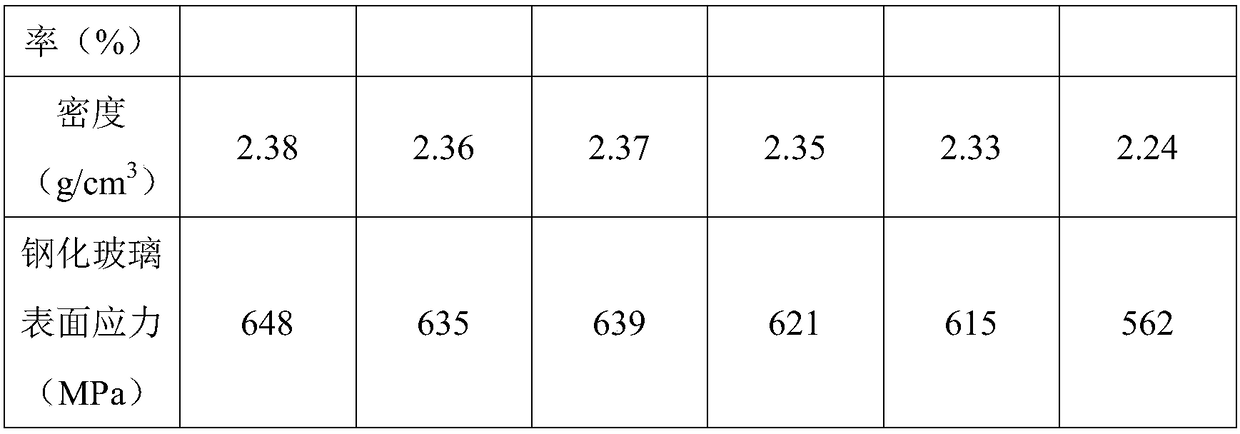Composite glass clarifying agent
A technology of composite glass and clarifying agent, which is applied in the field of glass manufacturing, can solve the problems of poor efficiency and defoaming, and achieve the effects of maintaining stability, increasing stability, and not being easily broken
- Summary
- Abstract
- Description
- Claims
- Application Information
AI Technical Summary
Problems solved by technology
Method used
Image
Examples
preparation example Construction
[0028] The preparation method of high temperature resistant defoaming composition comprises the following steps:
[0029] S1. In an oil-water bath at 68-80°C, mix hydrogen-containing silicone oil and allyl polyether at a mass ratio of 2-4:1, stir magnetically at 350-550r / min for 25-45min, add hydrogen-containing silicone oil of 3-6 % catalyst, heat up to 90-100°C, heat-preserve for 3-5 hours, then depressurize and pump for 20-45 minutes under the pressure of 0.01MPa to obtain modified silicone oil. 4: From 15 to 25, take white carbon black, sodium silicate, and water and mix them in the reaction kettle, stir magnetically at 550 to 850r / min for 35 to 60 minutes, heat up to 100 to 110°C, and add 5 to 8 times the mass of white carbon black Mix methyl silicone oil and stir magnetically at 400-650r / min for 35-55min to obtain a paste; S2. In terms of parts by mass, take 15-25 parts of silicone paste, 10-15 parts of Parts of simethicone, 18-28 parts of paraffin, 3-6 parts of emulsif...
Embodiment 1
[0034] Salt material: mix sodium sulfate, cerium oxide, tin dioxide, and calcium sulfate in a mass ratio of 4:1:0.3:1 to obtain salt material.
[0035]Oil phase: Mix hydrogenated castor oil and cottonseed oil at a mass ratio of 5:1 to obtain the oil phase.
[0036] Catalyst: platinum-palladium catalyst.
[0037] Additive: Mix gelatin and soybean lecithin at a mass ratio of 1:3 to obtain the additive.
[0038] Emulsifier: Mix polyoxyethylene oleate and sodium dodecylbenzenesulfonate at a mass ratio of 5:1 to obtain an emulsifier.
[0039] Thickener: Mix polyacrylamide and sodium alginate at a mass ratio of 3:1 to obtain a thickener.
[0040] Auxiliary agent: Mix Glauber's salt, nano silicon dioxide and silicon tetrahydrogen in a mass ratio of 1:2:1 to obtain the auxiliary agent. Preparation of compound viscous fluid: in parts by weight, take 10 parts of acrylamide, 12 parts of sodium dimethyl bisacrylamide sulfonate, 8 parts of sodium bicarbonate, and 40 parts of water, and ...
Embodiment 2
[0048] Salt material: Mix sodium sulfate, cerium oxide, tin dioxide, and calcium sulfate at a mass ratio of 6:1:0.3:2 to obtain salt material.
[0049] Oil phase: Mix hydrogenated castor oil and cottonseed oil at a mass ratio of 6:1 to obtain the oil phase.
[0050] Catalyst: palladium-silver catalyst.
[0051] Additive: Mix gelatin and soybean lecithin at a mass ratio of 1:5 to obtain the additive.
[0052] Emulsifier: Mix polyoxyethylene oleate and sodium dodecylbenzenesulfonate at a mass ratio of 5:2 to obtain an emulsifier.
[0053] Thickener: Mix polyacrylamide and sodium alginate at a mass ratio of 5:1 to obtain a thickener.
[0054] Auxiliary agent: Mix Glauber's salt, nano silicon dioxide and silicon tetrahydrogen in a mass ratio of 1:3:1 to obtain the auxiliary agent. Preparation of compound viscous fluid: in parts by weight, successively take 13 parts of acrylamide, 18 parts of sodium dimethyl bisacrylamide sulfonate, 10 parts of sodium bicarbonate, and 50 parts o...
PUM
| Property | Measurement | Unit |
|---|---|---|
| quality score | aaaaa | aaaaa |
Abstract
Description
Claims
Application Information
 Login to View More
Login to View More - R&D
- Intellectual Property
- Life Sciences
- Materials
- Tech Scout
- Unparalleled Data Quality
- Higher Quality Content
- 60% Fewer Hallucinations
Browse by: Latest US Patents, China's latest patents, Technical Efficacy Thesaurus, Application Domain, Technology Topic, Popular Technical Reports.
© 2025 PatSnap. All rights reserved.Legal|Privacy policy|Modern Slavery Act Transparency Statement|Sitemap|About US| Contact US: help@patsnap.com


